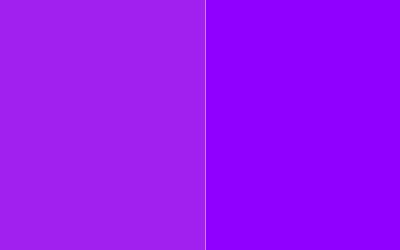Purple and violet can be highly confusing. Indeed, many people think they’re the same color, only in different shades.
Purple seems like pale violet, while violet looks like a darker shade of purple.
The biggest confusion is when you mix blue and red and can’t tell whether the result is purple or violet.
Or when shopping for paint and cannot differentiate between the two. I’ve been there.
So, I prepared this guide to help you finally understand the difference between the two colors.
What’s the Difference Between Purple and Violet?
Purple Vs Violet Color: The main difference between purple and violet is that purple is an unnatural color created by mixing red and blue in equal proportions. It does not exist naturally.
Meanwhile, violet is a true color that forms part of the electromagnetic spectrum. True colors exist only in nature and cannot be made by mixing other colors.
What is a Violet Color?

Violet is named after violet flowers. It sits between the wavelengths of blue and invisible ultraviolet light at the short-wave end of the electromagnetic spectrum.
It has a hex code of #8F00FF on the RGB chart. Thus, it comprises 56.1% red, 100% blue, and 0% green.
Meanwhile, on the CMYK color chart, it comprises 44% cyan, 100% magenta, 0% black, and 0% yellow.
The hue angle is 273.6 degrees, the lightness is 50%, and the saturation is 100%. On the color wheel, it is a mix between blue and purple.
In optics, violet is a spectral color. This means it is a single wavelength of light on the visible light spectrum.
You can find it between blue light, which has a longer wavelength, and ultraviolet, which has a shorter wavelength.
Remember that ultraviolet light is invisible to humans. Meanwhile, the wavelength of violet ranges from 380 to 435 nanometers.
Read also: what colors make violet?
Violet has many meanings and applications in different cultures. For instance, the Roman kingdoms associated violet with royalty and luxury. Only emperors, monarchs, and princesses wore violet.
Additionally, violet has spiritual and mystical associations. For instance, many societies associate violet with energy and mindfulness.
It also represents imagination, dreams, and the future.
Above all, violet is a counterculture color popular among artists itching to push their boundaries.
It combines best with its complementary color – yellow. Alternatively, use it next to blues and greens to add depth.
What is Color Purple?

Combine equal amounts of red and blue to make purple with acrylic paint. This mixture creates the perfect midpoint between the two colors on the RYB color wheel, resulting in vibrant purple shades.
Alternatively, you can find purple between magenta and violet on the CMYK color chart.
Thus, you can combine ultramarine blue, magenta, and titanium white at 1:15:3 to make the perfect purple.
It has the hex code #A020F0 on the RGB color chart, meaning it comprises 62.7% red, 94.1% blue, and 12.5% green.
Meanwhile, it comprises 33% cyan, 87% magenta, 6% black, and 0% yellow on the CMYK color chart.
If it interests you, the hue angle of purple is 276.9 degrees, the lightness is 53.3%, and the saturation is 87.4%.
However, purple is a non-spectral color not part of the visible light spectrum.
It’s not part of the seven rainbow colors identified by Isaac Newton because it lacks an individual wavelength.
Instead, if you notice a purplish color in the rainbow, it’s typically a combination of red and blue wavelengths.
Like violet, it has many meanings and associations. For instance, purple is a royal color.
It was worn by Roman royals, from magistrates to bishops. It’s also associated with emperorship and aristocracy in ancient Japan.
Also, the British royal family wears purple on special occasions.
Besides royalty, lighter shades of purple are considered feminine, nostalgic, and sentimental. Strangely, the color also has calming properties.
What’s the Main Difference Between Violet and Purple?
The main difference between violet and purple is that violet is a true color that exists naturally.
True colors are pure and standalone. You cannot make them by mixing other colors.
The best examples are the three primary colors, red, blue, and yellow. Similarly, mixing two or more colors cannot make true violet.
On the other hand, purple is a secondary color made by mixing blue and red.
The other major difference is how we “see” these two colors on the famous visible light spectrum.
The so-called spectral color range is a small portion of the electromagnetic light spectrum between 380 and 700 nanometers.
It comprises more than a dozen colors. But the six most vivid ones are red, blue, yellow, green, orange, and violet.
Unfortunately, our eyes cannot detect colors outside the visible light spectrum.
The details are complex. But, essentially, our eyes have two types of photoreceptors (the cells that help us perceive light).
Cones help us see in daylight, while rods are more active at night or in dim light. More importantly, cones help us detect colors.
There are three types of cones to help us perceive short, medium, and long wavelength color – and the cells are extremely accurate.
Generally, we “see” short wavelength colors as blue, medium wavelengths as green, and long wavelengths as red.
However, the cells can also pick up two wavelengths simultaneously. When that happens, our brains automatically “mix” the two colors, forming a new one.
This is where violet and purple differ. The violet color is part of the visible spectrum. It is visible at a wavelength of 380 nanometers.
Meanwhile, purple is absent from the visible spectrum. Instead, when you perceive purple, it’s merely a mixture of two separate wavelengths, i.e., blue and red light.
Why Humans Confuse Purple for Violet and Vice-Versa
We confuse violet and purple for many reasons. As you may have gathered, the main one is the close resemblance. One looks like a lighter shade of the other and vice versa.
The other major reason is that purple is conspicuously missing from the visible light spectrum.
The visible spectrum contains all three primary colors (red, blue, and yellow) and two secondary colors (green and orange). That leaves out purple. And guess the replacement? Violet.
It makes an already confusing matter even more complex because our minds immediately think of purple -not violet – when encountering other secondary colors.
The worst part is that mixing blue and red can give you purple or violet. Regular blue and red form purple.
But a small misstep leads to violet. So, you may mix one or the other without knowing it.
Purple vs Violet color: Head to Head
Hopefully, you’ve learned enough about purple and violet to distinguish and choose between the two.
But if you haven’t, the following head-to-head comparison simplifies everything.
1. Purple vs Violet: descriptions
Purple and violet closely resemble. They look like a mixture of red and blue light and are nearly indistinguishable by the naked eye. But they are different.
Violet light is a spectral color with an individual wavelength. It is found at the shortwave end of the visible electromagnetic spectrum. Thus, violet it’s a true color.
True colors are actual colors that you cannot make by combining a set of colors. The best examples are primary colors. Violet is similar. It exists naturally.
On the other hand, there’s no true purple light. There’s no individual wavelength that the human eye perceives as purple.
Instead, if you “see” purple, it’s merely two distinct wavelengths from red and blue light hitting the retina simultaneously.
Such colors are known as composites. Mixed colors don’t exist naturally. Instead, they are man-made colors created by mixing two or more colors.
2. Purple vs Violet: technical specifications
One of the easiest ways to distinguish between purple and violet is to look at the technical specifications.
First, the two have completely different hex codes. On the RBG (Red, Blue, Green) color chart, purple has a hex code #A020F0. This means it contains 62.7% red, 12.5% green, and 94.1% blue.
Meanwhile, the RGB code for violet is #8F00FF, meaning it contains 56.1% red, 1% green, and 100% blue.
The codes of CMYK (cyan, magenta, yellow, and black) also differ. Purple contains 33% cyan, 87% magenta, 0% yellow, and 6% black.
Meanwhile, cyan contains 44% cyan, 100% magenta, 0% yellow, and 0% black.
You may also mention the hue angle, which describes the relative amount of redness and yellowness in colors, with 0 degrees denoting magenta/red, 90 degrees yellow, 180 degrees green, and 270 degrees blue.
Purple has a hue angle of 276.9 degrees, whereas violet color has a hue angle of 273.6 degrees. Thus, violet leans more toward blue, while purple leans more toward red.
3. Violet vs Purple: location on Newton’s color wheel
You cannot discuss colors without mentioning the color theory and Newton’s color wheel, an experiment by Isaac Newton to determine light’s main (or primary) colors.
To determine the components of natural light, Newton sent a ray of light into a dark room through a hole in the curtain, and then refracted the white light through a glass prism. The results were eye-opening.
He found that light comprises seven main colors, which he called “primary” colors.
The seven are red, orange, yellow, green, blue, indigo and violet, which most people memorize by the acronym ROYGBIV.
He called them “primary” because the different refracted color rays, well parted from others, cannot be refracted or changed further except by mixing them with other rays.
But conspicuously missing from Newton’s primary colors is purple. The color violet is somewhere between red and blue. But purple is nowhere to be found.
Instead, purple is only visible when you mix red and blue lights from the color wheel. This makes a massive difference when printing, painting, or mixing colors.
4. Violet vs Purple: color combinations
Unfortunately, old-school painters prefer to make their colors from scratch. So, you must know how to make “perfect” purples and violets using the colors at your disposal.
It’s easier to make purple. Violet, meanwhile, requires more adjustments.
To make the color purple, begin with red and add a little blue at a time while stirring to make a uniform purple.
The best reds to make the purple color are alizarin crimson, quinacridone magenta, and primary red.
Meanwhile, ultramarine blue and cobalt blue are the best blues to make purple.
Ultramarine blue makes dark purple, while cobalt blue makes a lighter shade of purple.
Similarly, crimson red makes cooler purples, while cadmium makes warm purple tones.
Alternatively, to make a muted tone of purple, mix it with its complementary color (yellow).
Meanwhile, to make a darker purple shade, mix it with a little burnt umber or phthalo green.
Mixing violet is a little more complex, though not impossible. To make the perfect violet color, mix magenta and cyan in a ratio of 1:1.
Mixing regular blue and red colors in a ratio of 2:1 forms violet too. But it creates “dirty” violet such as violet-red or violet-blue.
5. Purple vs Violet: color shades

Purple and violet come in more than a dozen shades each, with some of the shades almost similar.
Let’s begin with purple. Technically, any color between red and blue is called purple.
However, this definition isn’t universal. For instance, many American painters only consider blue-dominated spectral colors beyond blue as purple.
Meanwhile, many British artists call these colors violet.
A more global definition is found in the color theory, which only considers colors on the “lines of purples” on the CIE chromaticity diagram as real purples.
These colors are found between red and violet, excluding red and violet.
By this definition, the most famous purples are tyrian purple, han purple, royal purple, mauveine artists’ pigment purple (red-violet), and electric purple.
Other popular purple shades today are pale purple, mauve purple, thistle purple, and orchid purple.
Meanwhile, the main shade of violet is the color wheel violet, found precisely midway between blue and magenta.
It’s sometimes called “near violet.” Also common is electric violet, also known as middle violet or simply violet.
Finally, vivid violet is also popular at the extreme edge of the visible spectrum. It’s also known as extreme violet.
Other less common violets are ultra-violet, African violet, English violet, Chinese violet, grape, wisteria, lilac and lavender color.
6. Purple and violet in nature
Neither purple nor violet is abundant in nature. But a few special animals, plants, and minerals adorn these unique colors.
The sea snail, the purple dye murex, is one of nature’s best examples of purple. It’s not purple itself.
But it produces a substance that gradually turns its skin purple when disturbed.
As the name suggests, it’s one of the biggest sources of natural purple dye, an expensive fabric dye often associated with royalty.
Purple emperors, a class of butterflies, also carry purple shades. The purple color in the wings is only visible when the butterfly is in direct sunlight.
But it’s super majestic. Purple honeycreepers and purple sea stars are also purple-colored.
Meanwhile, some of the best examples of violet in nature are the rainbow, violet violas, and violet corals.
The so-called spectral colour is vividly visible on the rainbow. But it’s even more spectacular on violet violas and corals.
Violet violas are unique flowering plants containing anthocyanins. The family comprises over 500 species cherished for their delicate and colorful blooms.
Meanwhile, violet corals are fungi living in unfertilized grasslands rather than reefs.
They are commonly found near hardwood forests in Australia, Asia, and the Americas.
7. Violet vs Purple: complementary colours
Purple’s main complementary color is gold shades or yellow, which sits directly opposite purple on the famed color wheel. Mixing yellow and purple can create interesting color combinations and harmonies.
Citrus shades are, therefore, the perfect choice to contrast purple. The green-purple combination is another excellent contrasting choice, as are other colors directly opposite purple on the color wheel. These include mustard, lime green, and orange.
However, you’re not limited to contrasting colors when pairing purples. For instance, purple pairs wonderfully with neutrals such as gray and cream.
It’s also surprisingly beautiful alongside pink and blue. Combine all three, and you have a masterpiece.
A few designers also pull off purple and red. But the two colors clash. So, you must be brave to combine them.
Violet shares the same complementary colors. For instance, yellow is the main complementary color to contrast purple. But, again, you can pair violet with green and orange to terrific effect.
Alternatively, pick a color besides violet on the color wheel. These include purple, pink, indigo and blue.
Blue and grey are other colors to consider using alongside purple. Greys make violets pop while blues reinforce the cool, bold tone.
Find out more about gold silver color.
Applications of Violet and Purple Colors
Purple and violet have diverse applications. For instance, many brands use the two colors to evoke positive feelings and suppress negative emotions.
For example, purple walls reduce irritability and foster creativity. Many interior decorators also use purple or violet to signify royalty or luxury.
For instance, purple furniture is often associated with higher social classes.
How to Perfectly Mix Purple and Violet
Blue and red in equal portions make purple. Then you can add more blue or red to achieve brighter or darker purples.
Alternatively, many artists mix five parts blue and three red to make the predominant dark purple.
Meanwhile, mix equal parts of magenta and cyan (rather than primary blue and red) to make violet.
Violet vs Other Close Variations
The main variations of violet are ultraviolet (Pantone), African violet, English violet, and lavender.
They are lighter or darker shades of violet. However, deep magenta is the best pick if you’re looking for colors close to violet on the color wheel.
It has plenty of red, making it appear like a deeper-colored version of violet.
Lilac vs Violet: What’s the Difference?
Lilac and violet (and purple) closely resemble. But they are different colors. Lilac is a pale shade of violet (or purple) with a pinkish hue.
It’s named after the lilac flower, an attractive, sweet-smelling flower that blossoms in early summer before roses and other summer flowers come alive.
Violet vs Lavender Color: What’s the Difference?
Lavender is a lighter shade of violet. It’s named after the lavender plant, a popular plant with many meanings.
For instance, lavender represents purity, devotion, silence, grace, serenity, and calmness. It also speaks the language of luxury and refinement.
However, the typical lavender paint has slightly more yellow than regular violet.
Magenta vs Violet: What’s the Difference?
The difference between magenta and violet is most evident in the Munsell color system.
Violet and red, the two colors making magenta, are at the opposite extremes of the Munsell color spectrum.
Therefore, magenta lands between red and violet if you wrap the spectrum, forming a color wheel. Thus, some people call it red-purple.
Read also about: Cream Vs Beige
FAQs
Are violet and purple the same?
No, violet and purple are not the same. They are near-identical when viewed side by side as they both combine red and blue. But, scientifically, they are different colors. Violet is a spectral color found on the color wheel, whereas purple is an additive color derived by mixing blue and red pigments.
Is violet a shade of purple?
Technically, no. Violet isn’t a shade of purple because the two colors exist differently. Violet is a spectral color that exists independently. Meanwhile, purple is a composite (man-made) color derived by mixing blue and red. However, when painting, you can “create” violet by adjusting specific shades of purple.
Is Violet a cool color?
Yes, violet is a cool color. It leans towards cool colors on the color wheel. Other cool colors are green and purple. But note that violet is not a “cold” color. The difference between the two is marginal. But generally, cold colors are extremely cool. Only blue meets this criterion. That aside, violet is perfect for applications requiring cool colors.
Is purple a cool or warm color?
Purple can be cold or warm, depending on the setting. It sits midway between blue and red on the color wheel. Therefore it can create different moods, depending on the colors used alongside it. For instance, purple colors next to blue create an overall sad mood. Meanwhile, purple alongside red creates an upbeat mood.
What does red and purple make?
Purple and red combined produce magenta, a rich and vibrant hue. Blending these primary and secondary colors results in a beautiful shade found in various artworks, designs, and natural phenomena, adding a touch of allure and charm to the visual spectrum.
Summary
Purple and violet colors can be highly confusing. Indeed, many people consider them the same. But they aren’t.
Violet is a true color found on the visible electromagnetic spectrum, while purple is a composite color derived by mixing two true colors (red and blue).











Leave a Reply